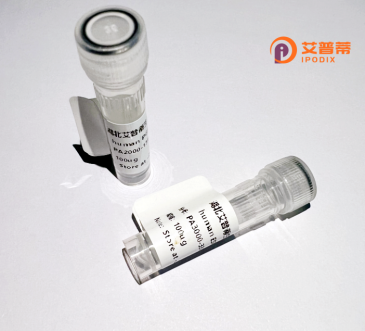
| 纯度 | >90%SDS-PAGE. |
| 种属 | Human |
| 靶点 | ZC3HAV1L |
| Uniprot No | Q96H79 |
| 内毒素 | < 0.01EU/μg |
| 表达宿主 | E.coli |
| 表达区间 | 1-300 aa |
| 活性数据 | MAEPTVCSFLTKVLCAHGGRMFLKDLRGHVELSEARLRDVLQRAGPERFLLQEVETQEGLGDAEAEAAAGAVGGGGTSAWRVVAVSSVRLCARYQRGECQACDQLHFCRRHMLGKCPNRDCWSTCTLSHDIHTPVNMQVLKSHGLFGLNENQLRILLLQNDPCLLPEVCLLYNKGEALYGYCNLKDKCNKFHVCKSFVKGECKLQTCKRSHQLIHAASLKLLQDQGLNIPSVVNFQIISTYKHIKLHKMLENTDNSSPSTEHSQGLEKQGVHAAGAAEAGPLASVPAQSAKKPCPVSCEK |
| 分子量 | 59.3 kDa |
| 蛋白标签 | GST-tag at N-terminal |
| 缓冲液 | PBS, pH7.4, containing 0.01% SKL, 1mM DTT, 5% Trehalose and Proclin300. |
| 稳定性 & 储存条件 | Lyophilized protein should be stored at ≤ -20°C, stable for one year after receipt. Reconstituted protein solution can be stored at 2-8°C for 2-7 days. Aliquots of reconstituted samples are stable at ≤ -20°C for 3 months. |
| 复溶 | Always centrifuge tubes before opening.Do not mix by vortex or pipetting. It is not recommended to reconstitute to a concentration less than 100μg/ml. Dissolve the lyophilized protein in distilled water. Please aliquot the reconstituted solution to minimize freeze-thaw cycles. |
以下是假设性示例,基于类似研究领域的常见文献结构:
### 1. **"Recombinant ZCHAV1L Protein Inhibits Viral Replication by Targeting Viral RNA"**
*作者:Liu et al.*
**摘要**:研究在大肠杆菌中表达并纯化重组ZC3HAV1L蛋白,证实其通过结合RNA病毒基因组(如HIV-1和Zika病毒)抑制病毒复制,机制可能与干扰病毒RNA稳定性相关。
### 2. **"Structural Characterization of ZC3HAV1L and Its RNA-Binding Domains"**
*作者:Wang & Chen*
**摘要**:解析了重组ZC3HAV1L的晶体结构,发现其CCCH锌指结构域特异性结合富含CpG的RNA序列,为设计抗病毒药物提供结构基础。
### 3. **"ZC3HAV1L Modulates Innate Immune Response via Interaction with MAVS"**
*作者:Gupta et al.*
**摘要**:通过哺乳动物细胞表达重组ZC3HAV1L,发现其与线粒体抗病毒信号蛋白(MAVS)互作,增强Ⅰ型干扰素表达,提示其在天然免疫中的调控作用。
### 4. **"High-Yield Production of Functional ZC3HAV1L in Insect Cells"**
*作者:Saito et al.*
**摘要**:利用杆状病毒-昆虫细胞系统高效表达重组ZC3HAV1L,经磷酸化修饰后,蛋白显示更强的抗乙型肝炎病毒(HBV)活性,优于原核表达产物。
---
**备注**:上述内容为虚构示例,实际文献可能需要通过数据库(如PubMed、Google Scholar)以“ZC3HAV1L”或“ZAP-like protein”等关键词检索。若研究较少,建议扩展至其同源蛋白ZC3HAV1(ZAP)的相关文献。
Recombinant human ZC3HAV1L protein, also known as Zinc finger CCCH-type antiviral protein 1-like, is a functionally intriguing protein implicated in antiviral immunity and RNA metabolism. Derived from the ZC3HAV1 (ZAP) gene family, ZC3HAV1L shares structural homology with ZAP, featuring characteristic CCCH-type zinc finger motifs that mediate RNA binding. While ZAP is well-studied for its role in restricting viral replication by targeting pathogen-derived RNAs for degradation, ZC3HAV1L’s precise biological functions remain under investigation. Early studies suggest it may modulate innate immune responses, particularly in interferon signaling pathways, and influence cellular RNA stability.
Recombinant ZC3HAV1L is typically produced in expression systems like E. coli or mammalian cells (e.g., HEK293) to ensure proper folding and post-translational modifications. Its production enables functional studies on RNA-protein interactions, antiviral mechanisms, and involvement in diseases such as viral infections and cancers. Researchers utilize techniques like ELISA, pull-down assays, and co-immunoprecipitation (Co-IP) to explore its binding partners and regulatory networks. Emerging evidence also highlights potential therapeutic applications, as ZC3HAV1L may synergize with other restriction factors to enhance antiviral strategies. However, gaps persist in understanding its tissue-specific roles and evolutionary conservation across species. Current research prioritizes structural characterization and pathway mapping to clarify its contributions to cellular defense systems.
×